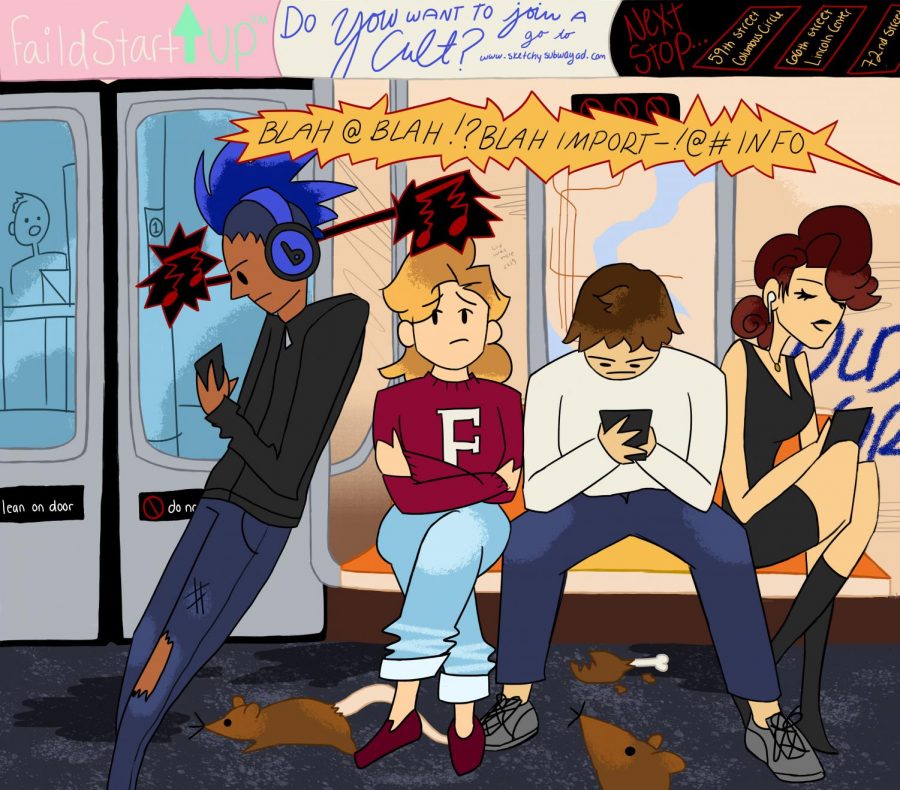A Dummy’s Guide to the MTA
September 17, 2019
For New York newcomers, the subway evokes images of rats, delays and some memorable characters. While these associations are not untrue, as a seasoned veteran of the MTA, here is some advice to avoid a trainwreck of an experience. Whether you’re perusing this article because the F train is late again or because you’ve freshly arrived in the city, everyone can learn how to make subway travel a safer, more pleasant experience.
Be one with the turnstile
There is a very specific MetroCard swiping speed required to unlock the turnstile. New Yorkers have mastered this speed and can get it on the first try, pushing through the turnstile in one smooth gesture. Swipe your card too fast or too slow, though, and you’ll get the dreaded error message: “SWIPE CARD AGAIN AT THIS TURNSTILE.” In an attempt to provide useful information for once, the perfect speed, the MTA declared, is anywhere between 10-40 inches per second, or 0.57-2.27 m.p.h. As usual, this information is helpful to exactly no one.
Don’t wreck your trek: plan ahead
Google Maps and Citymapper may give you projected travel times, but they don’t account for delays. On average, almost a third of subway trains arrived late in 2018. To avoid being late, leave at least 15 minutes early in case there are unexpected delays or route changes. It’s also not uncommon for a train to indefinitely stop in between stations to let another train pass, or to remain at a station with its doors open before departure.
Furthermore, Google Maps doesn’t always adjust its directions according to planned service changes. For the most accurate travel information, go directly to the source: the MTA website. Service changes are especially abundant during Friday nights and weekends, which are timed so as to not disrupt weekday commuters. You might find that a certain train isn’t running to your stop, in which case the MTA will run a free shuttle bus service or suggest alternate trains to take.
Hold onto something
Don’t think you’re cool by going hands-free — you won’t be when the train lurches and you suddenly go careening into a stranger’s lap. (However, do note that touching a subway handrail is equivalent to shaking hands with 10,000 people … so if you’re squeamish about germs like me, store a bottle of hand sanitizer in your bag or pocket.)
Additionally, under any circumstance, do not lean against a door: they could open at any time, even when the train is going full speed.
Make room
It’s the kind thing to do to give up your seat when you see someone that needs it, most often a pregnant woman or an elderly passenger. However, never assume they would like your seat. Instead, you can simply ask, “Would you like to sit down?” You can also offer to switch seats to keep families with children together, or give up your seat to accommodate someone who is holding a lot of bags or suitcases.
Not only is this courtesy, it’s also logical — letting others off the train first makes more space for you to go inside. Once everyone has gotten off, push forward into the car as much as you can — don’t just stand by the doors. Otherwise, you’ll have to deal with people brushing uncomfortably close to you. Got a backpack? Place it between your feet on the ground. This way, you’ll be able to keep your belongings in sight and avoid inadvertently smacking someone in the face.
Stop, look & listen
Many trains have an automated voice that announces stops, but to ensure you know where you are, look out the window and search for the station name. If your train doesn’t have an automated voice, the stops will be announced by the conductor. Sometimes the speaker systems garble the message, so you may have to really listen closely. Though long subway rides are considered prime time to listen to music, having your AirPods on full-blast may prevent you from hearing the announcements. If you hear the speakers go off, pause your music and listen carefully.
Learn your exits and use the platforms to your advantage
Exits can be confusing, but Manhattan’s grid system helps to demystify them. Stations almost always have exits to the blocks immediately north and south of the street in the station name. For example, 59 St. – Columbus Circle (the station closest to campus) has exits to both 60th and 57th Streets. If you’re trying to get to Fordham’s campus, which is on 60th Street, then you’ll want to take the 60th Street exits to emerge as close to school as possible. After riding the subway enough times, you’ll start to get an idea of where exits are located relative to the platform. Say you’re trying to get to school: while you’re waiting for the train to come, walk to the northern end of the platform and board the train there. When you arrive at Columbus Circle, you’ll end up by the 60th Street exits (whereas the southern end of the platform would bring you closer to the 57th Street exits).
When in doubt, ask for help
Though New Yorkers may seem aloof at times, they love to give directions, and will never pass up the chance to show off how much they know about the subway. If you’re lost, or just want to make sure you’re going in the right direction, feel free to ask the person next to you.
But you won’t have to, because you read this.











